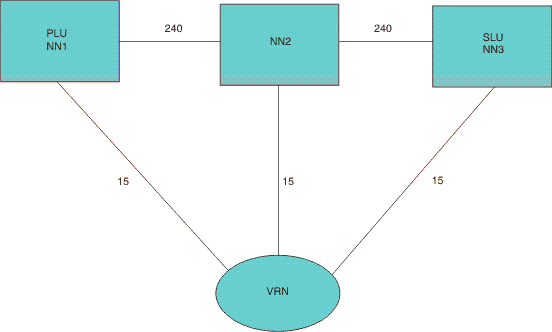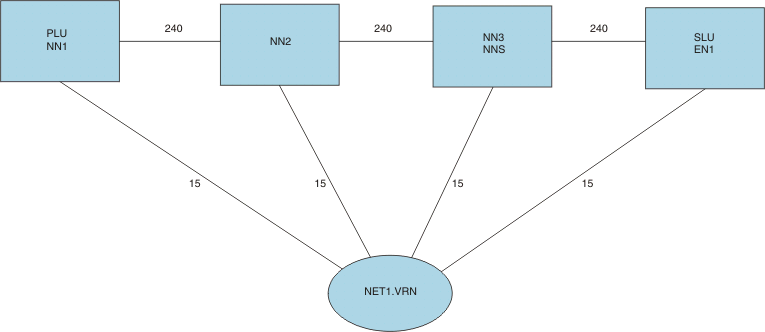 z/OS Communications Server: SNA Network Implementation Guide
z/OS Communications Server: SNA Network Implementation Guide
 z/OS Communications Server: SNA Network Implementation Guide
z/OS Communications Server: SNA Network Implementation Guide
|
Previous topic |
Next topic |
Contents |
Contact z/OS |
Library |
PDF
Route selection anomalies z/OS Communications Server: SNA Network Implementation Guide SC27-3672-01 |
|
|
When one path to a partner node over an Enterprise Extender VRN is unreachable, it is possible that the alternative route selected might not be the least weight route from the PLU node to the SLU node. Figure 1 and Figure 2 are examples of configurations in which this can occur. Figure 1. Connection network reachability example 1
 In the configuration shown in Figure 1, the route is calculated in the network node where the PLU resides. The weights of the TGs between the network nodes NN1 and NN2, and between the network nodes NN2 and NN3, are each 240. The weight of the TG between each network node and the VRN is 15, making the paths through the VRN preferred over the direct connections between nodes. Assume that NN3 is an unreachable partner on the path from NN1, through the VRN, to NN3, meaning that this route will not be selected for session setup. The other paths through the VRN are still acceptable for route selection. With this unreachable path eliminated, the next least weight route goes from NN1, through the VRN, to NN2, through the VRN a second time, to NN3. However, to prevent the calculation of circular routes, VTAM® Topology and Routing Services does not allow any node to exist more than one time in a selected route. Therefore, the final route is the higher weight route from NN1, through the VRN to NN2, then from NN2 to NN3. Figure 2. Connection network reachability example 2
 In the configuration shown in Figure 2, the route is also calculated in the network node where the PLU resides. The weights of the TGs between the network nodes NN1 and NN2, between the network nodes NN2 and NN3, and between network node NN3 and end node EN1, are each 240. The weight of the TG between each node and the VRN is 15, making the paths through the VRN preferred over the direct connections between nodes. Assume that NN2, NN3, and EN1 are all unreachable partners on the paths from NN1 through the VRN, meaning that these routes will not be selected for session setup. The other paths through the VRN are still considered to be usable for route selection. With the unreachable paths eliminated, the next least weight route goes from NN1 directly to NN2, then through the VRN to EN1. However, because of the way that routing trees are built, VTAM Topology and Routing Services puts the path from NN1 to the VRN on the tree first. It must remain on the tree because it will be checked later, after the tree is completed, to determine whether the endpoint TG from the VRN to EN1 can be used. This means that, because the VRN is already on the tree, it cannot be added again for the path from NN2 to the VRN (because a node is not allowed to exist more than one time in a routing tree, to prevent circular routes). The same is true for the path from NN3 to the VRN. Therefore, the final route is the higher weight route from NN1 to NN2, from NN2 to NN3, and then from NN3 to EN1. 


|
 Copyright IBM Corporation 1990, 2014 Copyright IBM Corporation 1990, 2014 |